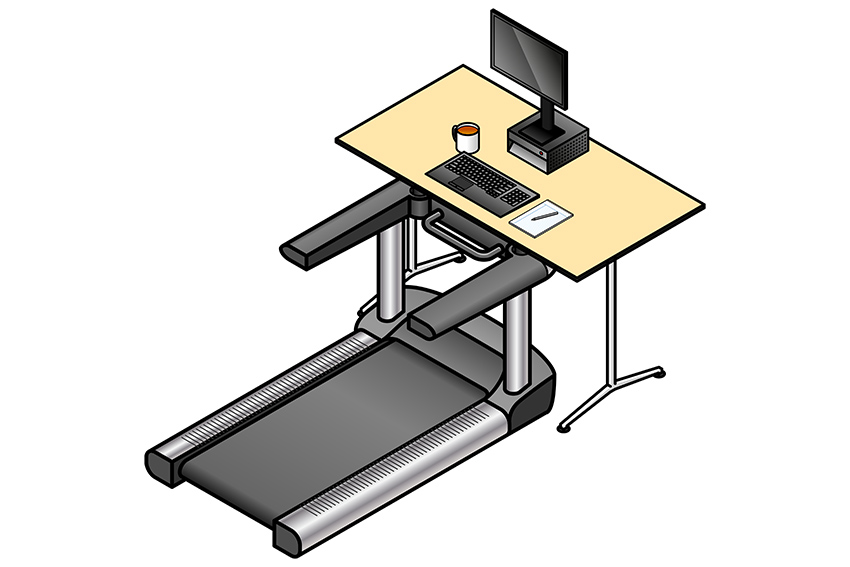- Apply
- Visit
- Request Info
- Give
Study finds that treadmill desk use improves work performance
Written by Molly Boucher
Published on October 25, 2022
 Eastern Connecticut State University Psychology Professor Jenna Scisco has completed compelling research that may impact the way people work from home in a post-COVID world. Titled “‘It’s Been a Game Changer’: A Qualitative Study of Treadmill Desk Use When Working from Home,” the research explores the motivators and barriers for treadmill desk use in a work-from-home setting. Completed with four undergraduate research assistants — Emma Meyers ’22, Andrew Miceli ’22, Jordyn Powell ’22 and Katelyn Kawabe ’21 — the qualitative study explored 20 different participants’ experiences with a treadmill desk.
Eastern Connecticut State University Psychology Professor Jenna Scisco has completed compelling research that may impact the way people work from home in a post-COVID world. Titled “‘It’s Been a Game Changer’: A Qualitative Study of Treadmill Desk Use When Working from Home,” the research explores the motivators and barriers for treadmill desk use in a work-from-home setting. Completed with four undergraduate research assistants — Emma Meyers ’22, Andrew Miceli ’22, Jordyn Powell ’22 and Katelyn Kawabe ’21 — the qualitative study explored 20 different participants’ experiences with a treadmill desk.
With a focus on occupational health research, Scisco has used her own treadmill desk since 2015, finding multiple benefits including improved focus and mood. During COVID-19 and quarantine, many found themselves looking for ways to stay active and engaged throughout the day, however, Scisco found that there was a large gap in research for the motivators and barriers of treadmill desks.

“I learned that all the past research on the effects of treadmill desk use has been conducted either in laboratories or offices, with no studies examining their use at home,” explained Scisco. “However, the home environment is particularly important to understand due to the recent increase in working from home caused by the COVID-19 pandemic.”
By interviewing 20 treadmill desk users who work from home with the help of her undergraduate research assistants, Scisco collected extensive data on the multiple positive physical, mental, social and work-related outcomes. In order to be eligible for the study, participants had to have a treadmill desk at home, work from home at least one day per week, live in the United States, and be at least 18 years old. Participants completed a pre-screening and 23-item structured questionnaire before being interviewed by Scisco and three of her students, Meyers, Miceli and Powell.
While barriers to treadmill desk use were discovered in the research, many of the outcomes were positive. “Barriers to use included the type of work being done, physical limitations, accessibility issues, social concerns and mental barriers such as boredom,” said Scisco. However, “some of the most intriguing outcomes were experiencing better focus, improved creativity, improved mood and feeling more satisfied with one’s work.” Some participants found themselves feeling a sense of accomplishment and pride, as well as more energy, relief of stress and a better work-life balance.
Recently, Scisco presented her research at the Annual Conference of the Canadian Society for Psychomotor Learning and Sports Psychology in Montréal, Québec. “Presenting was a wonderful opportunity to share research conducted at Eastern, and in collaboration with Eastern students, with an international audience. There was a great deal of interest in our research topic, and many conference attendees that I spoke to were seeking out information to help them decide if they should try a treadmill desk themselves,” said Scisco.
As for where the research will go from here, Scisco says the work is not done. She explained that future research should “investigate ways to increase treadmill desk use at home by capitalizing on motivating factors and reducing barriers to use.” She also stated that with these findings, the benefits may result in employers encouraging treadmill desk use for employees working from home. “Employers can support employees’ use of treadmill desks when working remotely by providing financial support for their purchase and positive reinforcement for their use,” said Scisco.


